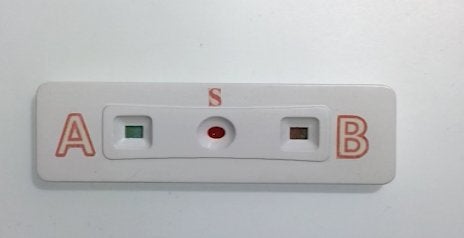A new test can detect your blood type with color-changing paper
It could be crucial in emergency situations and remote areas

Knowing a person’s blood type is crucial in medicine. If a traumatic injury leaves you in need of a donor’s blood, an infusion from the wrong blood type can result in a life-threatening reaction. But not everyone knows their blood type off the top of their head (I don’t, and I am a self-proclaimed hypochondriac). Blood typing is typically a lengthy process that requires a lab and all the equipment that comes with it. But in a report out this week in the journal Science Translational Medicine, researchers have come up with a better method: A paper-based test that identifies a person’s type with just a few drops of blood. They say this test could be most helpful in emergency and remote areas, where conventional blood typing isn’t feasible.
Traditional blood typing requires the use of a centrifuge, which spins the blood and separates it into its different components. Since most remote locations don’t have this type of equipment, the holy grail of blood type detection has been to design a process that doesn’t need a centrifuge.
The researchers worked around the need for a lab by finding a common dye—bromocresol green—that interacts with blood. What makes people have different blood types—A, B, AB, and O (as well as some other rare types)—is that each has different antigens and antibodies. Antigens are specialized proteins that sit on the outside of red blood cells, and antibodies are proteins that your body produces to fend off invaders. If a person has blood type A, they will have A-type antigens and B-type antibodies. The opposite is true for people with blood type A.
The device looks like a long thermometer with two ends. One the left end the user would place a solution containing antibody A and on the right end she would place a solution with antibody B. Then a drop of blood would be placed in the center, followed by a drop of the dye. The solution would travel down the paper and reach both antibody solutions. If the blood type was A, then the left solution—with a combination of antibody A, antigen A, and dye—would turn brown, and the right solution—with a combination of antibody B, antigen A, and dye—would turn teal. If the blood type were B, the left solution would be teal and the right solution would be brown. Type AB, in which both antigens are found on red blood cells, would turn both solutions teal, and type O, with no antigens at all, would turn both solutions brown.
The color change happens within 30 seconds, which is much faster than traditional testing which takes hours or days in a lab. The researchers tested 3,550 blood samples and had an accuracy rate of 99.9 percent. Further, because the result relies on a simple color change (which people who have red-green color blindness can also detect), it’s easy for first responders or people in remote areas to use.
While the results seem promising, the work is still in its proof-of-concept stage. More testing is needed to ensure the test can hold up in a variety of settings. The researchers also want to expand its ability to identify rarer blood types, or ones where the interaction between the antigens and the antibodies isn’t as strong. The current test also can’t distinguish blood from other fluids, which could contain antigens that produce color changes. Nevertheless, if this test makes it out into the real world, it could be a game-changer for remote or point-of-care medicine.
